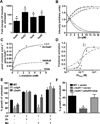The Response of Acinetobacter baumannii to Zinc Starvation
- PMID: 27281572
- PMCID: PMC4901392
- DOI: 10.1016/j.chom.2016.05.007
The Response of Acinetobacter baumannii to Zinc Starvation
Abstract
Zinc (Zn) is an essential metal that vertebrates sequester from pathogens to protect against infection. Investigating the opportunistic pathogen Acinetobacter baumannii's response to Zn starvation, we identified a putative Zn metallochaperone, ZigA, which binds Zn and is required for bacterial growth under Zn-limiting conditions and for disseminated infection in mice. ZigA is encoded adjacent to the histidine (His) utilization (Hut) system. The His ammonia-lyase HutH binds Zn very tightly only in the presence of high His and makes Zn bioavailable through His catabolism. The released Zn enables A. baumannii to combat host-imposed Zn starvation. These results demonstrate that A. baumannii employs several mechanisms to ensure bioavailability of Zn during infection, with ZigA functioning predominately during Zn starvation, but HutH operating in both Zn-deplete and -replete conditions to mobilize a labile His-Zn pool.
Copyright © 2016 Elsevier Inc. All rights reserved.
Figures






Similar articles
-
The interplay between Acinetobacter baumannii ZigA and SltB promotes zinc homeostasis and cell envelope integrity.Infect Immun. 2025 Feb 18;93(2):e0042224. doi: 10.1128/iai.00422-24. Epub 2025 Jan 23. Infect Immun. 2025. PMID: 39846731 Free PMC article.
-
The Acinetobacter baumannii Znu System Overcomes Host-Imposed Nutrient Zinc Limitation.Infect Immun. 2019 Nov 18;87(12):e00746-19. doi: 10.1128/IAI.00746-19. Print 2019 Dec. Infect Immun. 2019. PMID: 31548324 Free PMC article.
-
An Acinetobacter baumannii, Zinc-Regulated Peptidase Maintains Cell Wall Integrity during Immune-Mediated Nutrient Sequestration.Cell Rep. 2019 Feb 19;26(8):2009-2018.e6. doi: 10.1016/j.celrep.2019.01.089. Cell Rep. 2019. PMID: 30784584 Free PMC article.
-
Acinetobacter: an emerging pathogen with a versatile secretome.Emerg Microbes Infect. 2018 Mar 21;7(1):33. doi: 10.1038/s41426-018-0030-4. Emerg Microbes Infect. 2018. PMID: 29559620 Free PMC article. Review.
-
Multidrug resistant Acinetobacter baumannii--the role of AdeABC (RND family) efflux pump in resistance to antibiotics.Folia Histochem Cytobiol. 2008;46(3):257-67. doi: 10.2478/v10042-008-0056-x. Folia Histochem Cytobiol. 2008. PMID: 19056528 Review.
Cited by
-
Bacterial Strategies to Maintain Zinc Metallostasis at the Host-Pathogen Interface.J Biol Chem. 2016 Sep 30;291(40):20858-20868. doi: 10.1074/jbc.R116.742023. Epub 2016 Jul 26. J Biol Chem. 2016. PMID: 27462080 Free PMC article. Review.
-
Human pleural fluid triggers global changes in the transcriptional landscape of Acinetobacter baumannii as an adaptive response to stress.Sci Rep. 2019 Nov 21;9(1):17251. doi: 10.1038/s41598-019-53847-2. Sci Rep. 2019. PMID: 31754169 Free PMC article.
-
Light Regulates Acinetobacter baumannii Chromosomal and pAB3 Plasmid Genes at 37°C.J Bacteriol. 2022 Jun 21;204(6):e0003222. doi: 10.1128/jb.00032-22. Epub 2022 May 23. J Bacteriol. 2022. PMID: 35604222 Free PMC article.
-
Zinc-Dependent Transcriptional Regulation in Paracoccus denitrificans.Front Microbiol. 2017 Apr 11;8:569. doi: 10.3389/fmicb.2017.00569. eCollection 2017. Front Microbiol. 2017. PMID: 28443074 Free PMC article.
-
Biosynthesis and function of 7-deazaguanine derivatives in bacteria and phages.Microbiol Mol Biol Rev. 2024 Mar 27;88(1):e0019923. doi: 10.1128/mmbr.00199-23. Epub 2024 Feb 29. Microbiol Mol Biol Rev. 2024. PMID: 38421302 Free PMC article. Review.
References
-
- Andreini C, Banci L, Bertini I, Rosato A. Zinc through the three domains of life. J. Proteome Res. 2006;5:3173–3178. - PubMed
-
- Attin T, Becker K, Hannig C, Buchalla W, Wiegand A. Suitability of a malachite green procedure to detect minimal amounts of phosphate dissolved in acidic solutions. Clin. Oral Investig. 2005;9:203–207. - PubMed
-
- Bruins MR, Kapil S, Oehme FW. Microbial resistance to metals in the environment. Ecotoxicol. Environ. Saf. 2000;45:198–207. - PubMed
MeSH terms
Substances
Grants and funding
LinkOut - more resources
Full Text Sources
Other Literature Sources
Molecular Biology Databases

